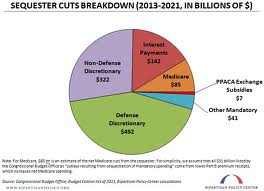Summary: What does sequestration mean? How did it come about? What legislation is involved?
What does it mean?
The official definition in terms of the budget is a US legal procedure in which automatic spending cuts are triggered. In a nutshell, effective  March 1, 2013, the government spending cuts go into effect in an effort to try to reduce the federal deficit which now is over $16 trillion. For 2013, the amount of spending cuts is estimated to be about $85 million, with additional cuts through 2021 for a total of about $1.2 trillion. These cuts are split evenly between defense and non-defense.
March 1, 2013, the government spending cuts go into effect in an effort to try to reduce the federal deficit which now is over $16 trillion. For 2013, the amount of spending cuts is estimated to be about $85 million, with additional cuts through 2021 for a total of about $1.2 trillion. These cuts are split evenly between defense and non-defense.
History
The Balanced Budget Act of 2011
So why did it come to sequestration? The Balance Budget Act of 2011 was an agreement as part of the debt ceiling crisis. The aim of the act was to create legislation that would decrease the deficit by $1.2 trillion over 10 years. The Joint Selection Committee on Deficit Reduction failed to create this legislation and as a result the Budget Control Act’s sequestration provision was enacted.
The Fiscal Cliff of 2012
The original effective date of the sequestration was January 2, 2013 but was postponed until March 1, 2013 as a result of the fiscal cliff which our nation faced at the end of 2012. The fiscal cliff was a result of several legislative provisions ending as of December 31, 2012 and several with effective dates of January 1, 2013. This collision provided quite a quandary for Congress, causing them to spend countless hours trying to hammer out and negotiate legislation.
Last ditch efforts February 28, 2013
February 28, 2013, 2 last minute proposals were offered in an effort to avoid the sequestration:
- Senator Harry Reid from Nevada proposed a deal, called the 50-50 measure which would attack the deficit evenly split between raising taxes and issuing spending cuts from defense and agricultural programs. Additionally, this proposal would have made exempt both Medicare and Medicaid. This proposal lost by a very slim margin of 51-49.
- Senators Jim Inhofe and Pat Toomey responded with an additional proposal which would require President Obama to submit a “sequestration replacement plan” of $85 billion in spending cuts by March 15. Defense cuts would have been limited to $42.6 billion. This proposal failed by a much larger margin 62-38.
March 1, 2013
After last ditch efforts failed, the sequestration was enacted as of March 1, 2013. The sequestration will provide for across the board spending cuts with quite a few exceptions including Medicare and Social Security.
Have you had your healthcare financial analysis performed lately? For more information, please contact our healthcare financial consultants.
BHM Healthcare Solutions www.bhmpc.com
Visit us www.bhmpc.com
Call us 1-888-831-1171
Email us at results@bhmpc.com






RT @BHMHealthcare: What Does Sequestration Mean? What is the History?: Summary: What does sequestration mean? How did it come … http:/ …